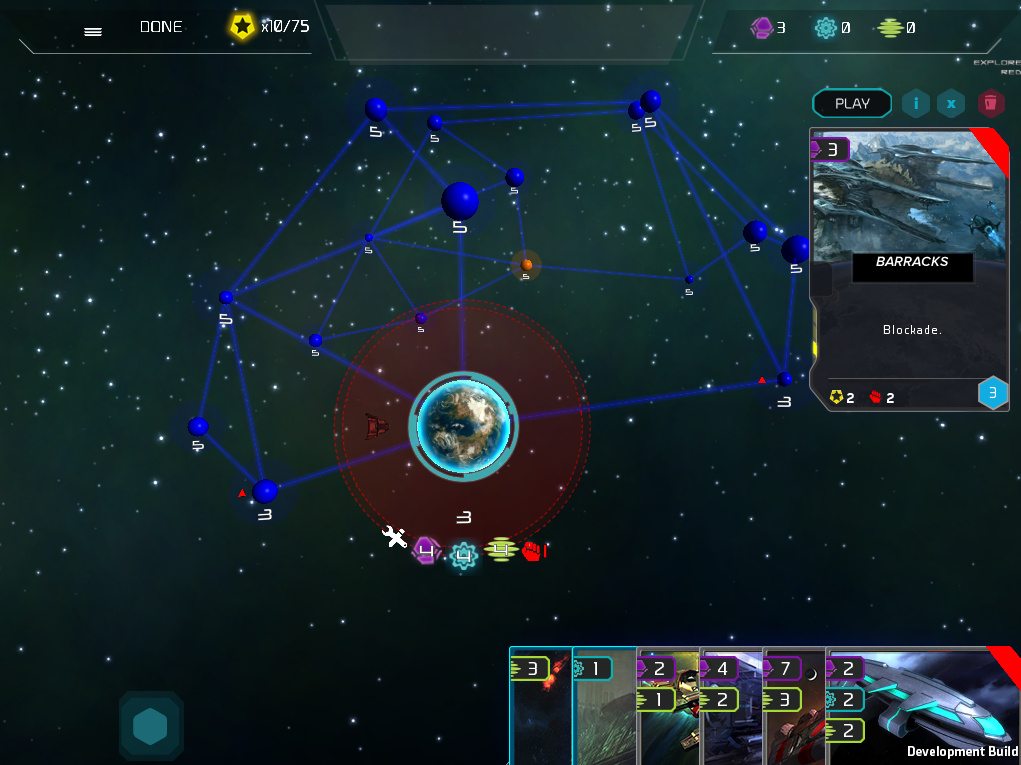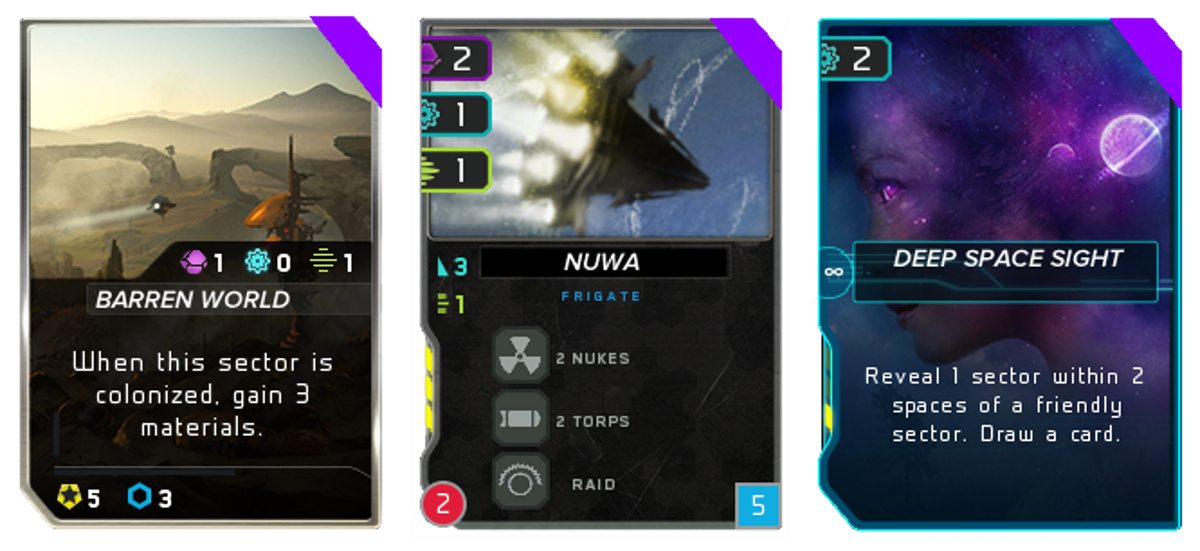
Without a large screen behind it, Gala Collider was easy to miss at PAX. They had two things going for them though: card mechanics and 4x strategy. I was drawn like a moth to flame. PAX Prime wasn’t a great venue to play the demo, being too loud to get a guided tour into the meat of the game. Fortunately, Marketing Mangager Nina Park was able to set up a session for me with Developer Trevor Worral to try out their early build. I was very excited by what I saw.
Gala Collider brings card mechanics to 4x space strategy games (eXplore, eXpand, eXploit, eXterminate). Set in a distant future when our galaxy collides with Andromeda, cards are used to put shipyards, developments, and spaceships into play on a three-dimensional map of connected star systems. Three resources are used to control the pace of the game: materials, research, and energy are needed to play your cards. Your colonized systems produce those resources at varying rates, and you have access to a market where you can trade two-for-one to get a particular resource when you really need it. In my playthrough, energy seemed particularly important as it is also used to move ships from system to system.
Players make their decks in advance of the game. However, Gala Collider brings a neat twist in that you also define a sideboard of high technology cards called the Tech Pool. This is a set of cards that are available to you, but are not in your deck at the start of the game. Players purchase cards from their Tech Pool during a game to add them to their deck. This gives you the flexibility of only adding higher-cost cards to your deck after you’ve assembled an economic engine, and allows you to specifically add in cards that can help you exploit a weakness of your opponent, or counter their strategy.

Your hand holds six cards, one of which is to make a new colony ship; this is the only card that doesn’t leave your hand when played. Cards are played in a few different ways, but the most common was to simply drag the card to the map: place a shipyard card on a system with an empty development slot and it will be built there next turn; put a battle effect on an enemy ship and it will activate during combat. The system was intuitive and let me focus on strategy instead of the user interface.
Gala Collider is a multiplayer game, currently aimed at two-player matches. There are two races in the game, and happily, they are asymmetric. Worral played the Sylith, whose different ships and abilities than my humanity-descended Coalition resulted in differences in our play styles. Rotating the three-dimensional map, I found defensible choke points to place my shipyards, built ships for defense of my worlds, and sent out other ships capable of capturing my opponent’s planets. The game showed me where my opponent’s ships were moving, but not what ships they were, leaving me to try to out-manoeuvre his plans and save key battle cards for the right moment. I was genuinely impressed by the strategic depth afforded in a game that was completed in just half an hour. Despite Park’s excitement that I might win, Worral took a key planet from me in a surprise move, tipping his victory point total over the winning threshold.
Not yet available to be shown was the game’s collectible card mechanics and interface. While I just said “collectible cards”, those of you who don’t want to get sucked into a trading card game should stick around: cards in Gala Collider are provided in predetermined packs. The universe will expand over time as more packs are added, similar to Fantasy Flight Games’ Living Card Games, so you’ll always know what cards you’re purchasing.

My only concern at this point is that the game is following a free-to-play model. That would have been a much larger worry in the days before Hearthstone and other games showed that F2P can be a fun environment for everyone, with paying players simply having more options. Gala Collider appears committed to that approach, with their goal being “an equal playing field” wherein F2P players can make a competitive deck through smart pack selections, while paying players will have a richer deck building experience. This will be Neocrux’s hardest challenge in their game design, and I’m looking forward to seeing how they pull off this balancing act.
The development build I played was definitely a work in progress, lacking the polish you would expect to see in the final product. Despite that, I saw some impressive-looking graphics for solar systems and combat, and the user interface was surprisingly robust for a game still in the middle of its Kickstarter campaign. The team has already proven they can put together a good-looking and compelling game, and I am hopeful that they should be able to deliver on their promises.
Gala Collider is initially targeted for iPad, PC, and Mac, but will likely grow to iPhone and Android if successful. As always, you should refresh yourself on our crowdfunding basics. Right after you do that, you should turn around and check out Gala Collider on Kickstarter, and make sure to watch their gameplay videos on their Youtube channel! It’s not every day that a new take shows up on the 4x genre, and I hope this easy-to-play yet strategically satisfying game gets its chance to shine among the stars.



